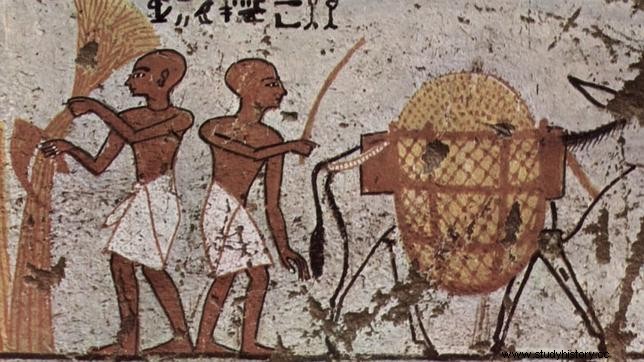It is often thought that beer has its origins in the Germanic peoples, and that, due to the Roman Empire and the popularity of wine, beer did not begin to be produced and spread until shortly after the invasions of the so-called barbarians. Beer was already known many years before by civilizations as old as the Sumerians or the Egyptians. Both in Upper and Lower Egypt, this drink was known and it was in Ancient Egypt that an industry dedicated to growing barley on the banks of the Nile and brewing beer for later consumption began to exist. The "invention" is attributed to the very god Osiris , son of Nut, lord of Abydos and Busiris, god of the underworld and judge of the dead (the Greek equivalent of Hades ), Osiris is thus the "regenerative spirit", the one who makes the crops germinate and regenerate each year thanks to the floods of the Nile. Beer, then, was highly valued both for its medicinal applications and for its nutritional value, as reflected in classical sources with more than 4,000 years, such as papyri, hieroglyphs, steles and authors such as Cicero or Diodorus of Sicily, attest to the existence of beer in those times.

First of all, it must be pointed out that beer in Ancient Egypt was not as we know it today; its composition was not 100% barley, it had different ingredients depending on the type of beer. It was usually made up largely of spelt (a variety of imported wheat possibly from Palestine, Cyprus or Turkey, as barley was much more expensive) and then there was a variety of beers. "Ordinary" beer used to be thick, cloudy and reddish in color, while other varieties such as beer for offerings to the gods, sweet beer or salty, had another composition. Sweet beer, for example, acquired that flavor by adding dates or honey, since sugarcane and beet sugar were unknown to the ancient Egyptians. Another curious fact is that this "regular" beer was sometimes so thick that it was not drunk, it was eaten. It could be filtered and drank later or drank through a straw, but it was also eaten, like the one eaten today as puree, gazpacho, custard or salmorejo.
According to a papyrus of the alchemist Zósimo de Panópolis, this was the brewing process that all brewers had to follow…
The germinated grains of barley and spelled are crushed in a mortar, and with their flour a paste is obtained that hardens with the feet in a vat. With this dough the beer breads are made, which are baked, leaving something moist inside. Once cold, they are split and placed in jars with sweetened water. After the addition of yeast, and finished the fermentation, it is transferred to a vat, diluting and sifting the crushed mass several times. The final liquid is saved and stored in cool caves.
This method had to be followed to the letter in all the nomos (provinces), and the nome (provincial governor) was responsible to the pharaoh for it to be so. Once elaborated, the container was sealed with baked clay to avoid mixtures and, by way of what we know today as "denomination of origin", a hieroglyph was inscribed on the lid of said container to certify the quality and origin of the product. beer.
Beer was also used for medicinal purposes and even as a means of payment on some occasions. Regarding its medicinal applications, there are many curious remedies that have been rescued from doctors and from the houses of life (Health centers of the time). Some doctors like Hesy-Ra who lived in 3,000 BC or papyri such as Ebers , Lahun or Hearst attest to Egyptian medicine. With regard to beer, among many other remedies, it was used as a diuretic or to avoid colds, drink beer in which an onion has been macerated. And as a curiosity, they also had a remedy for those who abused beer and the next day suffered its consequences in the form of a hangover ("the fatigue that wine gives «, Pliny the Elder called it):it was recommended to put around the neck a necklace of leaves of «ruscus racemosus «. If someone tries it, let them know how it went.
Collaboration of Pedro Sanmartín
